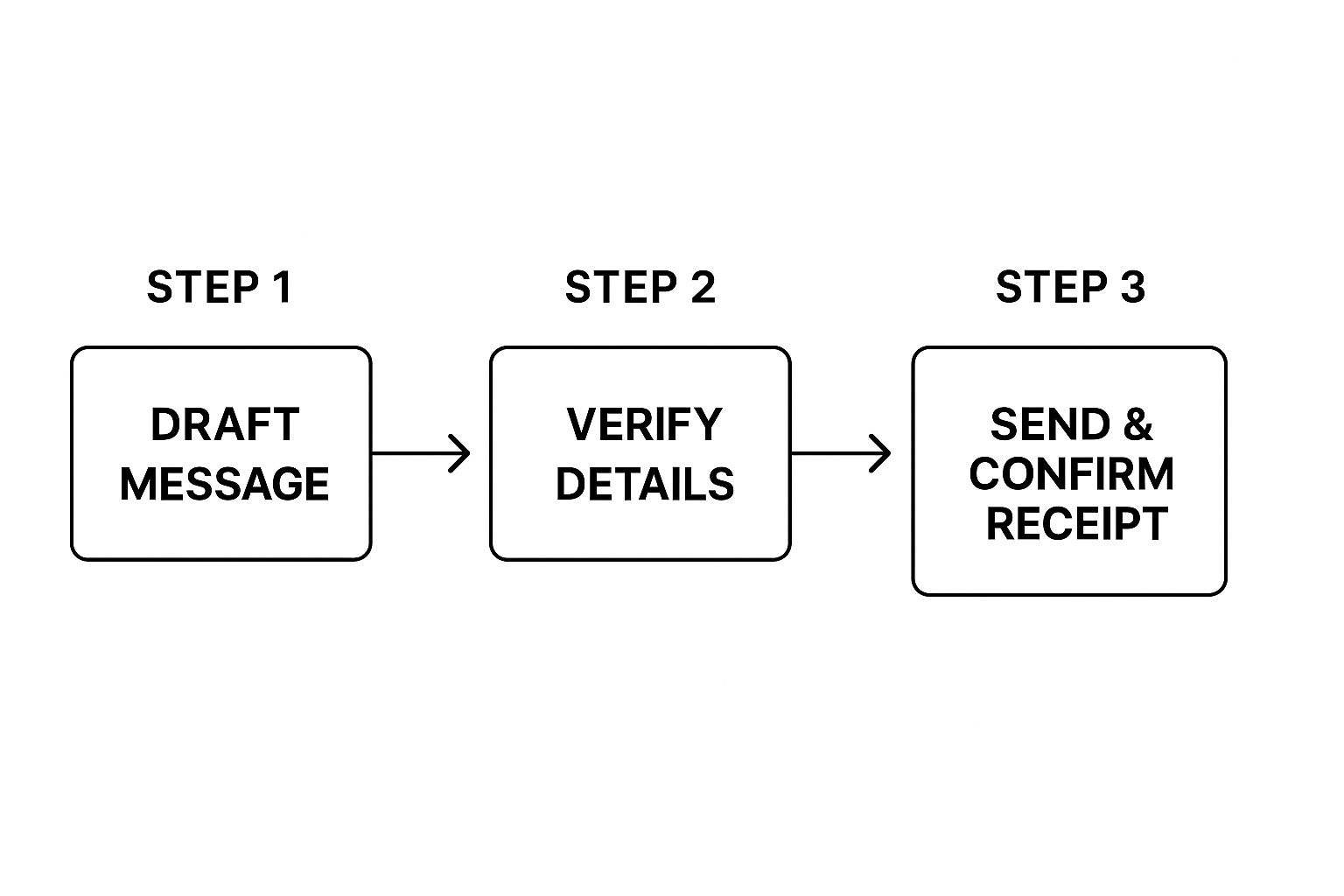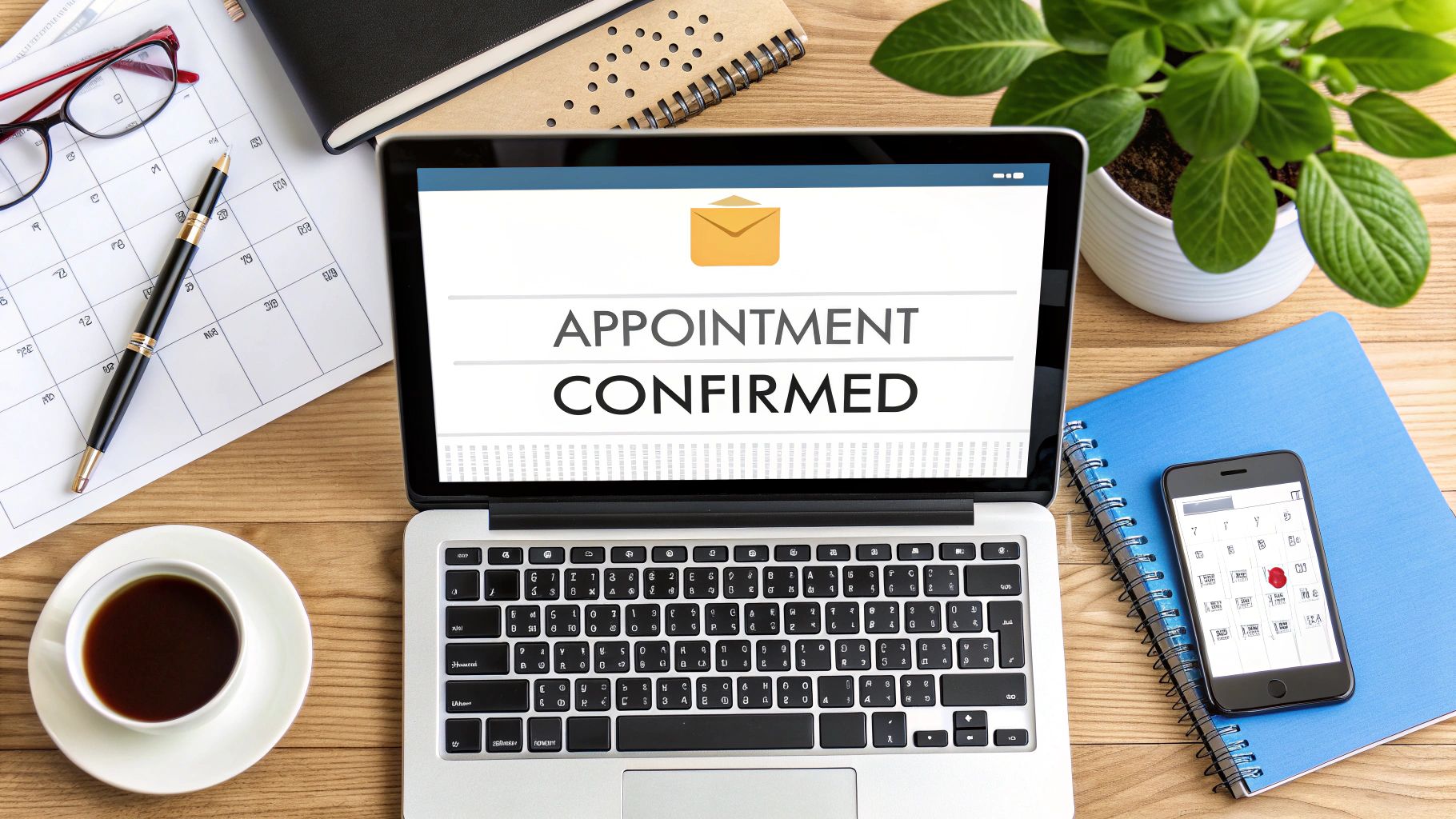An appointment confirmation email is so much more than a digital placeholder on a calendar. It’s your first real chance to build trust and slash those costly no-shows. This one simple message confirms all the important details, reassures your new client they made the right choice, and sets a professional, organized tone from the get-go.
Why Confirmation Emails Are Your Secret Weapon
Let's stop thinking about confirmation emails as just another admin task to tick off the list. Seriously. Think of each one as a strategic move that actively works for your business.
When someone books with you, they're putting their trust in your hands. A quick, clear, and professional confirmation email is the first piece of concrete evidence you can give them that their trust is well-placed. It instantly signals that you're on the ball, reliable, and care about their experience.
This isn't just about being polite; it has a real, direct impact on your bottom line.
The Real Cost of a No-Show
No-shows are the silent killer of revenue for any service business. Every appointment that gets missed is not just lost income; it's a wasted time slot that another paying client could have filled. A well-written confirmation appointment email is one of your most powerful tools to prevent this. It cements the commitment in the client's mind and gives them everything they need to show up on time and prepared.
Beyond the lost cash, no-shows can really drag down team morale and throw your whole day's schedule into chaos. A proactive confirmation strategy is your best defence. It takes a casual verbal agreement and turns it into a documented event on their calendar. That simple action creates a small psychological hook, making the client far less likely to forget or just not show up without letting you know.
For any business juggling multiple clients, this isn't a "nice-to-have." It's an essential part of keeping your operations running smoothly. If you want to dive deeper into managing these client touchpoints, check out our guide on getting started with LeadFlow Manager.
Your confirmation email is the bridge between a client's initial booking and their committed arrival. It’s your opportunity to lock in that appointment and protect both your time and your revenue.
To make sure you're including all the right pieces, here's a quick-glance table of the essential elements.
Essential Elements of a High-Performing Confirmation Email
table block not supported
Getting these elements right transforms a simple notification into a powerful tool for your business.
Proof From the Field
The results speak for themselves. In places like California, appointment confirmations have become a non-negotiable tool for service businesses looking to keep clients engaged. Data from scheduling platforms like Square Appointments shows that sending automated confirmation and reminder messages can cut no-show rates by a massive 20-30%.
That's a direct boost to your revenue and a major step toward a smoother, more predictable workday. It's a small effort with a huge payoff.
The Anatomy of an Unforgettable Confirmation Email
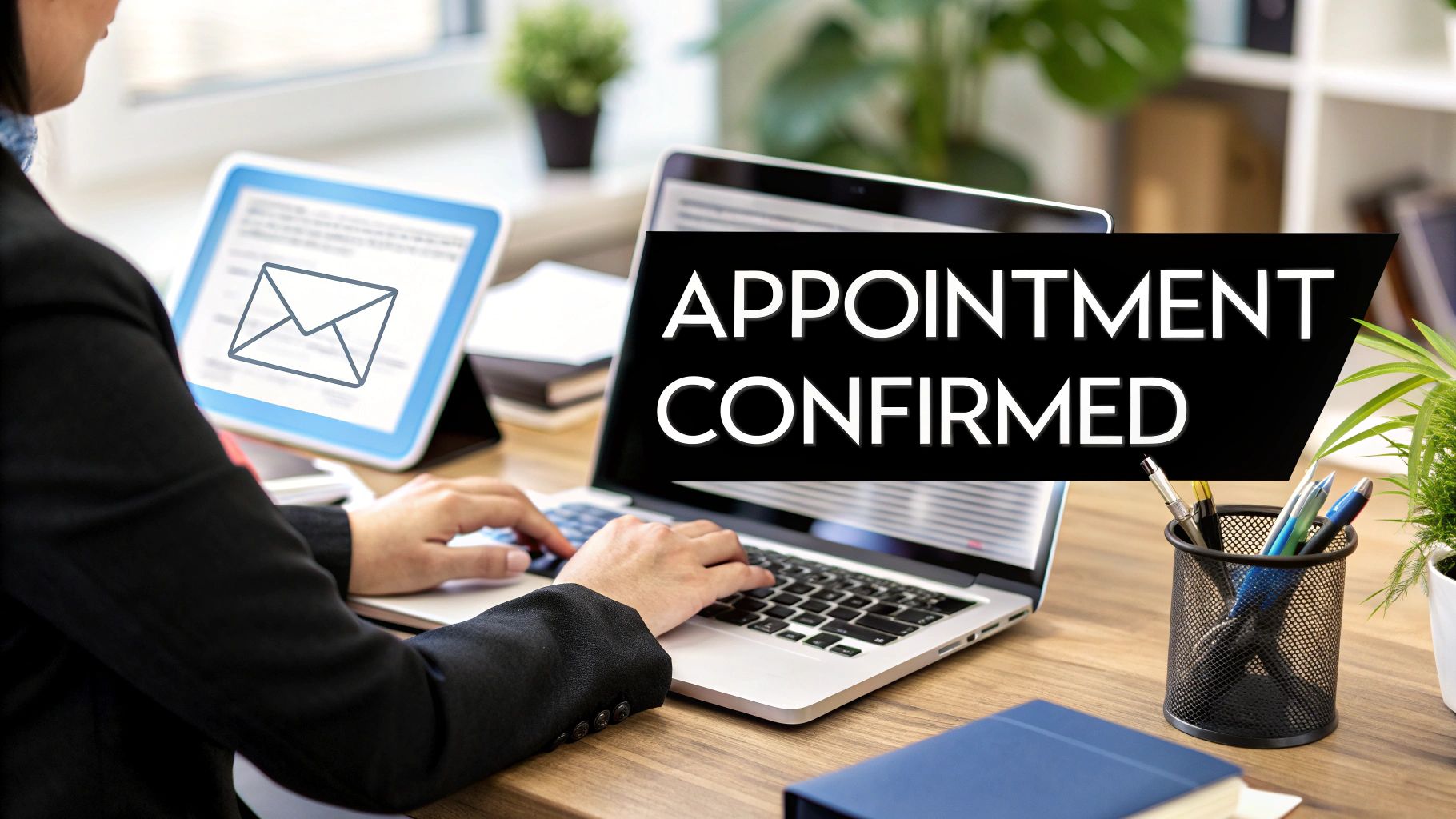
Alright, let's break down what turns a standard confirmation email into something genuinely helpful. The goal is to move beyond a basic calendar notification and create a message that actually adds value for your client. A truly great confirmation isn't just a wall of text; it's a well-designed tool that makes your client's life easier and reinforces that booking with you was the right call.
The secret? Make it scannable. Your client needs to pop open that email and instantly see the crucial details—what, when, and where—in seconds. This is no place for long, fluffy paragraphs.
Instead, you have to think like a designer and create a clear information hierarchy. The most important information gets top billing, front and centre. It’s a simple change that shifts your email from a purely functional message to a stellar customer service touchpoint.
Structuring for Absolute Clarity
The body of the email is where the magic happens. Don't bury the lead. After a quick, personalized greeting, get straight to the point and confirm the appointment. The key is to present those vital details in a way that’s impossible to miss.
So many businesses fall into the trap of using generic templates that make clients dig for the information they need. A much better approach is to use bold text or bullet points to lay everything out cleanly. It shows you respect their time and drastically cuts down on potential confusion.
Here’s a simple, no-nonsense way to format the core details:
- Service/Meeting: [Name of the Service or Meeting Purpose]
- Date: Tuesday, November 12, 2024
- Time: 2:30 PM (PST)
- Location: [Full Physical Address with a Map Link OR a Direct Video Call Link]
This layout is clean, direct, and looks great on a phone, ensuring your client gets the info they need without any friction. It answers their most important questions right away.
Including Essential Business Protections
Your confirmation email isn't just about logistics; it’s also the perfect spot to communicate policies that protect your business and set clear expectations. These are the details people often forget, but they're critical for running a smooth operation.
Your cancellation and rescheduling policies need to be stated clearly, but politely. This isn't about being harsh; it's about setting professional boundaries from the get-go. A simple line like, "Please provide at least 24 hours' notice for any changes," paired with a direct link to reschedule, gives the client control while protecting your calendar.
An effective confirmation email does more than just inform; it anticipates the client's needs and provides clear instructions, which is the cornerstone of a great customer experience. It’s your chance to answer their questions before they even have to ask.
Including these elements shows you're a professional who has thought everything through.
Adding Value with Pre-Appointment Instructions
Think about it from your client's perspective: what do they need to do to be ready for the appointment? This is your chance to set them up for success. A few simple instructions can prevent frustrating delays and show you care about their experience.
Consider what would make their life easier:
- Paperwork: If they need to fill out forms, give them a link to do it online beforehand. This is a huge time-saver for everyone involved.
- What to Bring: Do they need to have their ID, specific documents, or maybe some project files? List everything out so there are no last-minute scrambles.
- Arrival Details: For in-person meetings, mention where to park or if they should plan to arrive a few minutes early.
And finally, always include your contact information where it's easy to find. A phone number and a reply-to email address give clients a direct line to you for any last-minute questions. It’s a small detail that does wonders for building trust and showing you're there to help.
Writing Subject Lines That Actually Get Opened
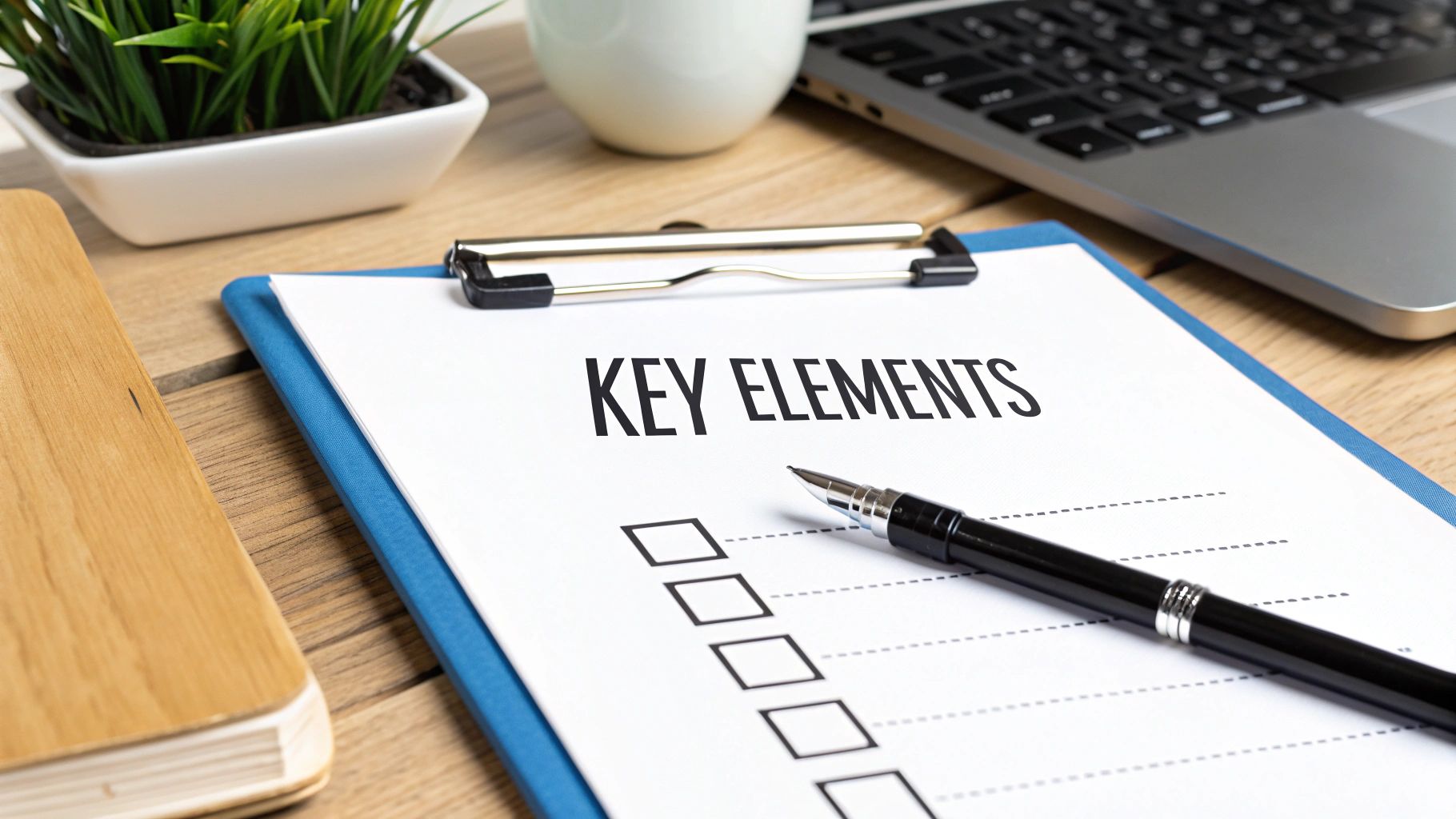
Think of your subject line as the gatekeeper for your entire confirmation email. If it’s weak, that brilliant, helpful email you spent time crafting won't even get seen. Your client's inbox is a battlefield, and generic phrases like "Appointment Confirmation" are casualties, easily ignored or worse, flagged as spam.
To win the click, your subject line has to signal value and relevance instantly. It’s a one-line pitch for why this email matters right now. A great subject line for a confirmation appointment email is clear, concise, and packed with just enough detail to be useful at a glance. It's the small touch that makes a client feel organized and respected, not annoyed.
Striking the Right Tone
Your subject line's tone needs to be a perfect match for your brand and the meeting's context. A financial advisory firm will naturally sound more buttoned-up than a laid-back creative agency. But no matter the vibe, clarity is non-negotiable.
For example, a client booking a high-stakes legal consultation needs a subject line that radiates professionalism and locks in the details. On the other hand, an email confirming a quick design review can feel more relaxed and collaborative.
Your subject line sets the stage for the entire interaction. Make it count by being direct and helpful, so they know exactly what the email is about before they even open it.
Getting the tone right shows you’re in sync with your client's expectations and establishes a positive dynamic from the get-go.
High-Performing Subject Line Formulas
Why guess what works when you can start with proven formulas? The best subject lines are scannable and actionable, combining key details that help your client immediately.
Here are a few powerful formulas you can adapt for your own business:
- Action + Key Detail: This approach actively confirms the booking and highlights a crucial piece of information.
- Brand + Purpose + Date: This structure is fantastic for reinforcing your brand while clearly stating the email's purpose.
- Personalized + Simple: Dropping in the client’s name or a project title is a simple way to boost your open rates.
These aren't rigid rules, but flexible starting points. Play around with them to see what clicks with your audience. Sometimes a tiny tweak, like adding a project name, can make a huge difference in how clients engage with your confirmation appointment email. The goal is always the same: make their life easier and keep your appointment top of mind.
Building Unshakable Trust in Your Communications
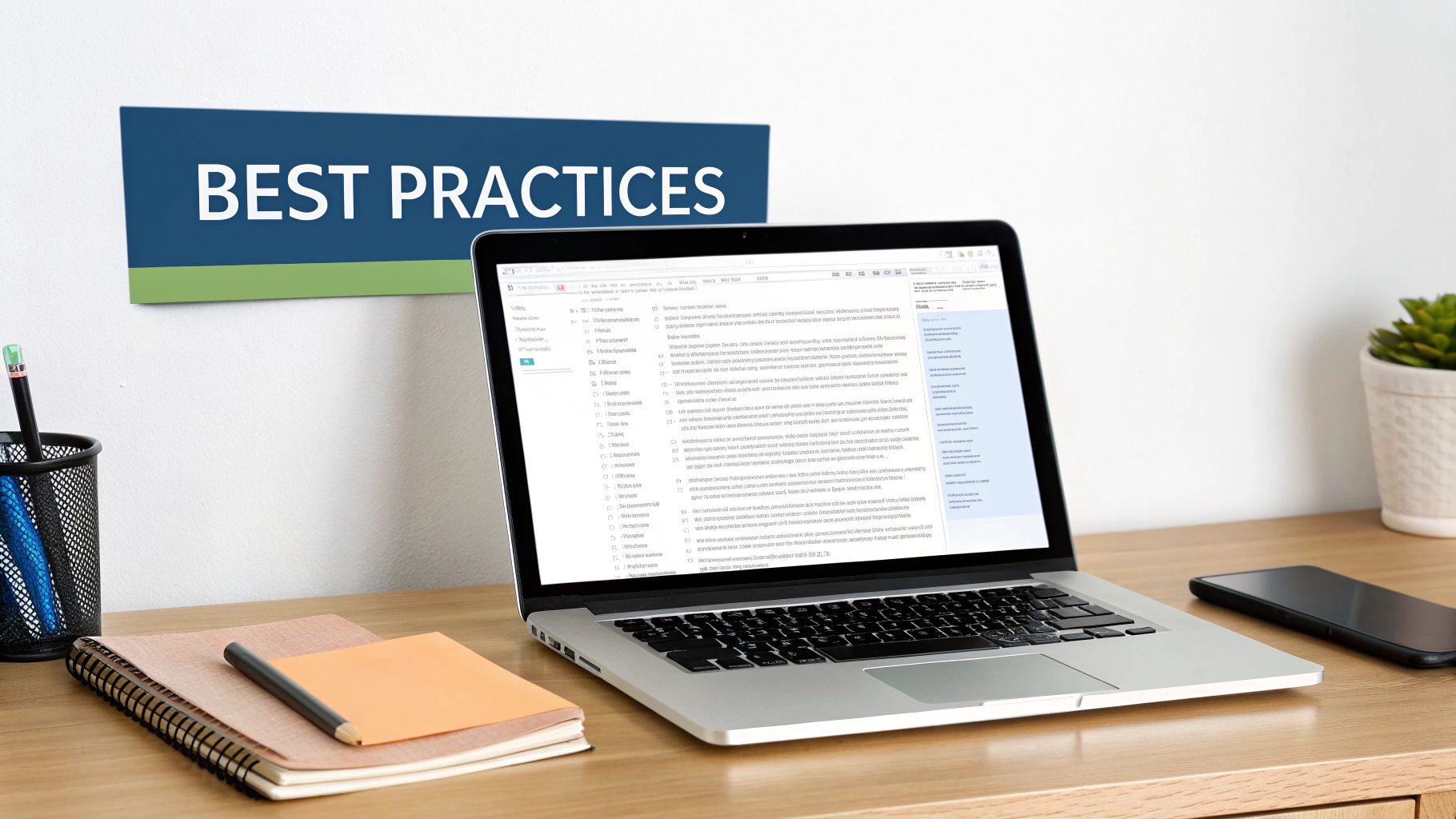
In a world where phishing scams and data breaches are a constant headline, even a simple confirmation email has a big job to do: build trust. It’s no longer just about locking in the date and time. Your communications need to scream security and professionalism, showing clients you take protecting their information seriously.
Think of it this way: every email you send is a tiny billboard for your brand's integrity. When clients see you’re being proactive about their safety, their confidence in your entire business grows. This all starts with some foundational security habits that are surprisingly easy to implement but have a massive impact.
For starters, always—and I mean always—send your confirmation appointment email from an official, branded email address. Something like [email protected] looks legitimate. An email from [email protected]? That immediately sets off alarm bells and chips away at the professional image you've worked so hard to create.
Taking a Page from the Experts
We can learn a ton from how official organizations handle their communications. Take the U.S. Census Bureau’s approach in California, for example. It's a masterclass in establishing authority. They only send emails from official "@census.gov" addresses and are crystal clear that they will never ask for sensitive info like Social Security numbers or bank details via email.
While specific data for California isn’t public, this transparent strategy has been shown to boost national survey participation by 10-15%. It's solid proof that trustworthy emails get better results. You can even check out the details on their secure contact methods right on their website.
This kind of transparency is a powerful tool for any business. By clearly stating what you will and won't ask for, you give your clients the power to spot scams and prove you're committed to their privacy. It builds a shield of trust around your brand.
By clearly stating what information you will never ask for in an email, you empower your clients to recognize fraudulent requests and reinforce your commitment to their data privacy.
A simple way to apply this is by adding a security-focused footer to your emails. It’s a small change that can make a world of difference in client confidence.
What to Put in Your Security Footer
- A Clear Statement: "We will never ask for your password, financial information, or Social Security Number via email."
- Official Channels: "All official communication will come from an @yourcompany.com email address."
- A Safety Net: "If you are unsure about a request, please contact us directly at [Your Official Phone Number]."
Putting these trust signals in place isn't just about protecting your clients; it's about protecting and enhancing your brand's reputation. For any business focused on growth, making every interaction secure and professional is non-negotiable. To dig deeper into this, you can explore more strategies in our guide on lead routing best practices to boost sales efficiency.
Optimizing Confirmations for Healthcare and Professional Services
When you’re in a field like healthcare or professional consulting, a generic confirmation appointment email just doesn't work. These industries are built on a foundation of trust, expertise, and strict confidentiality. Every single piece of communication you send out needs to reflect that.
Think about it: your email isn't just locking in a time slot. It's a chance to reinforce your credibility and reassure clients they've made the right choice.
For healthcare providers, the stakes are even higher. Your communication has to be crystal clear, genuinely helpful, and compliant with privacy laws like HIPAA. This means you can't just drop sensitive health information into an email, but you still need to provide all the necessary details. The real goal is to make the entire process feel effortless for the patient, easing any stress before they even walk through your door.
Likewise, for professional services—think legal, financial, or business consulting—these emails are a direct reflection of your brand. A vague or sloppy email can plant a seed of doubt. But a sharp, detailed confirmation does the opposite. It shows you’re meticulous and prepared, setting a fantastic tone for the valuable meeting ahead.
Tailoring Your Message for Patient and Client Trust
In a healthcare setting, clarity isn't just good practice; it's essential for patient care. It’s about much more than the date and time. Simple reminders, like asking a patient to bring their health card or a list of their current medications, can make a huge difference in how smoothly the appointment runs.
Getting timely information to the right person is a real challenge. A report from the California Department of Managed Health Care (DMHC) found that while 73% to 77% of health plan providers met timely access standards in 2022, a separate survey of behavioural health providers found that 18% of its intended recipients were ineligible simply due to wrong contact info. You can see the full breakdown in the DMHC's detailed report.
This really highlights how a basic confirmation email can also serve as a verification tool, helping you catch bad data before it causes a missed appointment and a break in care.
In healthcare, your confirmation email is a critical part of the patient care continuum. It must be designed to reduce anxiety, provide clear instructions, and protect sensitive information above all else.
For professional services, the email should deliver value beyond the basic logistics. This is your chance to link to a relevant case study, a helpful article you've written, or some pre-meeting materials that will make your session even more productive. This simple step positions you as a proactive expert, not just another service provider.
This same strategic approach is vital when managing large-scale professional events, which you can read more about in our guide to improving event marketing communications. By carefully tailoring your content, you can transform a standard administrative email into a powerful tool for building rapport and showing off your expertise from the very first interaction.
Your Confirmation Email Questions Answered
Even with the best templates, you're bound to run into some practical questions when setting up your confirmation appointment email system. Let's dig into some of the most common ones I hear and give you some direct, no-fluff answers to help you get it right.
When Is the Best Time to Send a Confirmation Email?
Timing is absolutely crucial. A solid confirmation strategy isn't just about a single email—it's about a well-timed sequence that keeps your appointment top-of-mind without being annoying.
First off, the initial confirmation has to go out immediately after someone books. Think of it as a digital handshake. It instantly reassures your new client that their booking went through and their spot is locked in. You completely eliminate that little moment of doubt where they're left wondering, "Did that actually work?"
Then comes the reminder. The sweet spot is 24 to 48 hours before the appointment. This window is close enough that they won't forget, but it still gives them enough time to reschedule without leaving you in the lurch if something has come up. If you're dealing with appointments booked months in advance, I'd also suggest a gentle heads-up about a week beforehand. It just helps them plan.
A confirmation email sent the moment an appointment is booked provides immediate reassurance. A reminder sent 24 hours prior significantly reduces no-shows. This two-part approach is a simple, powerful way to protect your schedule.
Should I Automate My Confirmation Emails?
Yes. One hundred percent, yes. Sending every confirmation and reminder by hand is not just a massive time sink; it's practically begging for mistakes. Automating these emails is one of the single biggest improvements you can make to your whole scheduling process.
Modern scheduling platforms are built for this. Automation means every client gets a professional, on-time confirmation without you having to do a thing. It keeps your communication consistent, makes sure nobody ever slips through the cracks, and frees up your team to handle the stuff that actually requires a human touch. And don't worry—you can still customize your templates to match your brand's voice and add specific details for different services, so you get all the efficiency without losing the personal feel.
When you break it down, the process is incredibly simple.
